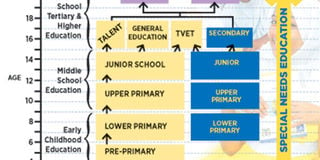Proposed education system endorsed

A new proposed format of basic education has been endorsed opening the way to the design of a new curriculum, the first since 1985.
What you need to know:
- Early school will take in ages of four and five for pre-primary followed by lower primary between six and nine, if the new proposal is adopted.
- Middle school will comprise upper primary and junior school.
- Graduates of junior school will have different pathways to either senior school, tertiary or higher education.
A new proposed format of basic education has been endorsed opening the way to the design of a new curriculum, the first since 1985.
More than 100 participants who attended a meeting at Safari Park Hotel on Friday were unanimous that the current primary and secondary education levels will be in three levels.
According to proposals at the meeting, there will be early, middle and senior schools.
Early school will take in ages of four and five for pre-primary followed by lower primary between six and nine, if the new proposal is adopted.
Middle school will comprise upper primary and junior school.
Graduates of junior school will have different pathways to either senior school, tertiary or higher education.
After junior school, learners will pick either talent schools, general education on technical and vocational education, or basic education and training.
The new curriculum also provides for clear ways for children with special needs to transit seamlessly from lower to higher education.
At the end of the half-day meeting on Friday, Kenya Institute of Curriculum Development Director Julius Jwan said the next stage is design and development of syllabuses.
“We can now confidently start the process of developing the subjects that will be taught at all levels,” Dr Jwan said.
Proposals of each stage will be presented for consideration.
Dr Jwan, a former Moi University lecturer, said doors were still open to Kenyans to provide input on the curriculum reform.
Under the proposed curriculum, learning at pre-primary and lower primary will only focus on foundation skills.
Middle school, comprising upper primary and junior school, will focus on broad-based exploration. Learners will select the path they wish to learn at subsequent levels.
Senior school, tertiary and higher education learners will specialise.
The Friday meeting also approved the broad areas that learning will focus on.
Pre-primary will focus on communication skills, basic literacy, numeracy and digital literacy skills for learning and enjoyment.
Education Cabinet Secretary Fred Matiang’i said the reform will be subjected to rigorous public participation.
He urged all players to debate the process professionally to ensure it was not depoliticised.
“Curriculum reforms have nothing to do with (2017) elections or any other form of politics,” he said.
Dr Matiang’i also said the government will allow adequate time for piloting. Universities will be allowed to prepare to handle the new graduates.
He said drafters of new curriculum will now start writing the syllabus.
Dr Matiang’i promised that teachers will be trained to implement the new curriculum.
Unicef Kenya country office education chief Daniel Baheta which has been supporting said the reform was a first in the region.
“We are seeing a process that is highly consultative and professional,” he said.




